- Home
- The Spring Garden
- Spring Flowering Shrubs F-P
Spring Flowering Shrubs F - P
The list of spring flowering shrubs continues . . .
Forsythia X intermedia, forsythia or yellowbells, Zones 6-8.
Forsythia is one of the most ubiquitous of the spring flowering shrubs. The bright yellow bell-shaped flowers shout the end of winter and are very welcome for it. There are cultivars in various shades of yellow from pale to deep gold. They are perfect in combination with yellow daffodils and other early spring bulbs. Best grown in full sun for maximum bloom.
Forsythias sort of fade into the background in the summer, but return to the stage in the autumn when they sometimes turn shades of burgundy to purple. The biggest mistake people make with forsythias is to prune them into stiff shapes. They look much more graceful if allowed to grow in their natural arching shape. If pruning is needed, just remove a few of the oldest canes from the base from time to time and trim back any irregular wayward branches. Easy to propagate by ground-layering, and they
will often do this for you--branches that touch the ground can easily take root
and form thick colonies.
 Forsythia x intermedia
Forsythia x intermediaFothergilla gardenii, dwarf fothergilla, Zones 5-8. I love the
little honey-scented bottle brush blooms of fothergilla in the
spring. They can be very effective in the shrub border as this
mass planting at Winterthur shows. They have the added benefit of having attractive blue-green foliage all summer that turns brilliant shades of orange to red in the fall. Dwarf means that they can grow to 5 - 6' as compared with F. major which grows to 6 -10'. Both are native American species. 'Mt. Airy' is a choice cultivar that is reliable for good fall color.
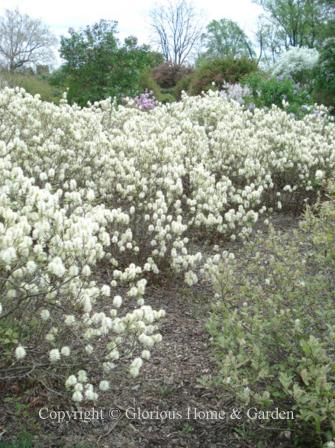 Fothergilla gardenii
Fothergilla gardeniiIndigofera decora, Chinese indigo, Zones 5-7. This is a small,
low-growing shrub or ground cover with long, pink flower racemes that give a sort of miniature wisteria effect. A nice ground cover for a partly shady situation, but be aware that it spreads via underground runners and could be invasive. This is a relative of Indigofera tinctoria from which indigo dye is derived.
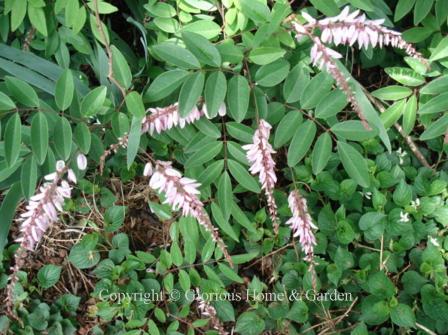 Indigofera decora
Indigofera decoraItea virginica, Virginia sweetspire, Zones 5-9. Another great
native American spring flowering shrub that deserves to be more widely planted. 'Henry's Garnet,' an improvement over the species, is shown. It has long, finger-like racemes of white
flowers in spring and brilliant red fall color. Virginia sweetspire likes moist soil and is adaptable to sun or shade. It will form large colonies through suckering where it is happy.
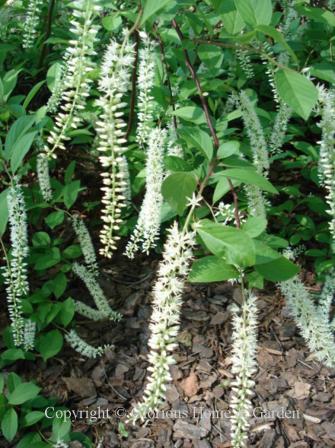 Itea virginica 'Henry's Garnet'
Itea virginica 'Henry's Garnet'Kalmia latifolia, mountain laurel, Zones 4-9. I love the buds
that look like little sugar icing stars and when they open, the
stamens look like the inverted spokes of an umbrella. A unique flower! Like its native conditions, mountain laurel prefers cool, moist, well-drained, acidic, humusy soil. A great North American native evergreen shrub.
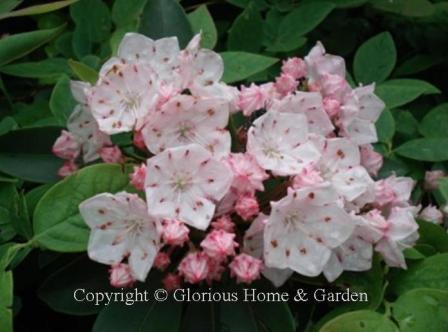 Kalmia latifolia
Kalmia latifoliaKerria japonica, Japanese kerria, Zones 4b-9. Small bright yellow flowers on slender green stems really brighten up a shady woodland setting. One of the earliest shrubs to bloom (I often have some opening in late January in a mild 7b winter), kerria has a long bloom period and even repeats a bit in late summer. There are single and double cultivars.
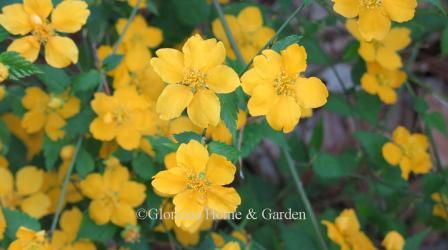 Kerria japonica
Kerria japonica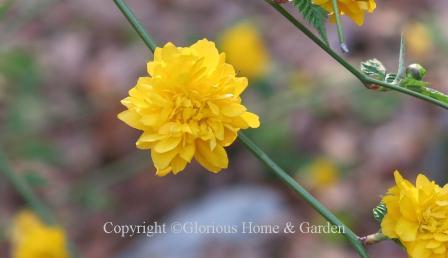 Kerria japonica 'Pleniflora'
Kerria japonica 'Pleniflora'Ligustrum japonicum, Japanese privet, Zones 7-10. Sort of a white lilac effect in bloom, but without the lovely fragrance--in fact, with a rather obnoxious fragrance--followed by black berries. Ligustrum can be used effectively for many purposes--hedges, screens, specimens. The dark, thick leathery leaves make an effective backdrop for other plantings.
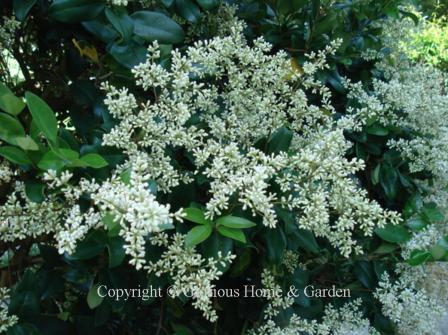 Ligustrum japonicum
Ligustrum japonicumLoropetalum chinense, Chinese fringe flower, Zones 7-9.
Loropetalums have exploded in popularity lately and seem to have become the darlings of landscapers, one sees them everywhere in the Southeast. They bloom early from late winter into April in mostly screaming pink, fuchsia or plum ribbony flowers (there are also white ones) that completely cover the evergreen foliage. There are green and purple-leaved types that are neat and tidy when out of bloom, and many different cultivars in various sizes from dwarf like 'Snow Muffin' to nearly tree size like 'Zhuzhou Fuchsia'. Great for foundations or hedges, but like forsythia they have a better appearance when allowed their natural shape and not stiffly pruned.
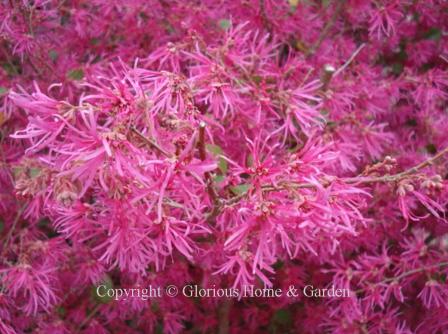 Loropetalum chinense var. rubrum 'Zhuzhou Fuchsia'
Loropetalum chinense var. rubrum 'Zhuzhou Fuchsia'Magnolia figo, banana shrub, Zones 8-10. A lovely evergreen shrub in the magnolia family for the South. The small, creamy flowers often marked with purple, are shaped like miniature Magnolia grandiflora blooms, and have a delightful fragrance like bananas. Likes full sun to partial shade and reaches a mature size of 6-10’ high and wide. Formerly known as Michelia figo.
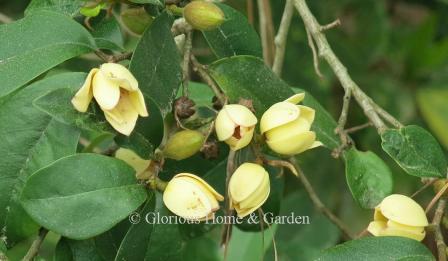 Magnolia figo 'Hagiwara Everblooming'
Magnolia figo 'Hagiwara Everblooming'Mahonia aquifolium, Oregon hollygrape, Zones 5-8. Native to the northwestern U.S., the Oregon hollygrape (or grapeholly) has leaves that look like holly and blue-black berries that look like grapes. Bright yellow flowers appear later than its Chinese cousin, Mahonia bealei.
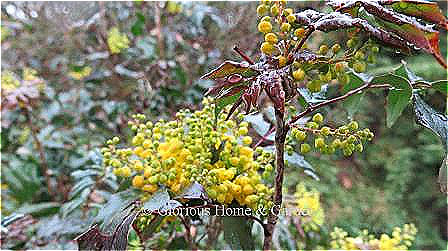 Mahonia aquifolium
Mahonia aquifoliumNandina domestica, nandina or heavenly bamboo, Zones 6-9. This shrub is appreciated more for the pendulous clusters of red berries in the fall and winter that for the flowers, but the airy white flower clusters foretell the show to come, and the leaves turn brilliant red in the autumn. However, it is invasive in some areas, particularly in the southeastern U.S., and new sterile cultivars have been developed with a focus on the foliage.
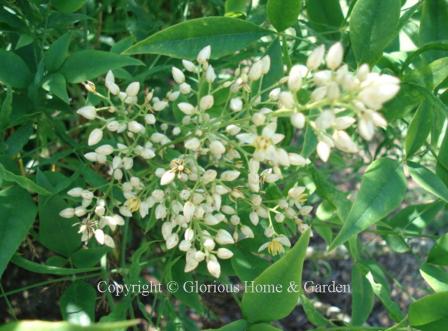 Nandina domestica
Nandina domesticaNeviusia alabamensis, Alabama snow wreath, Zones 4-8. Snow wreath is a charming, little-known native spring-flowering shrub that is worth seeking out. Fuzzy white flowers (actually the stamens) that remind me of ageratum adorn the shrub in April to May. Nice in a shrub border, it grows to about 3’ x 6’.
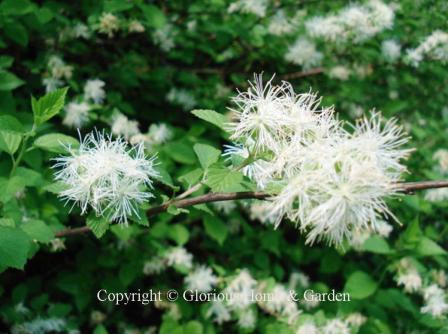 Neviusia alabamensis
Neviusia alabamensisPhiladelphus x virginalis, mockorange, Zones 4-8. Mock orange is a spring flowering shrub grown for its fragrant, white blooms that cover it in May. The cultivar, ‘Natchez,’ below, has larger flower than is typical and reaches about 6 to 8 feet. As mock orange is not particularly interesting out of bloom, and sort of fades into the background, place it accordingly as part of a shrub border, hedge, or screen. Still, for the time it does bloom, it puts on quite a show and fills the air with an orange blossom-like fragrance.
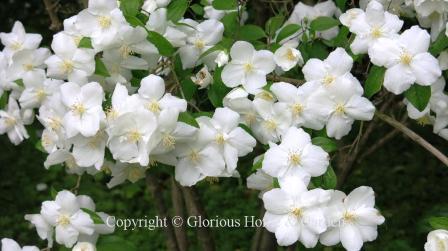 Philadelphis x virginalis 'Natchez'
Philadelphis x virginalis 'Natchez'Pieris japonica, Japanese pieris or lily-of-the-valley shrub, Zones 4b-7. Pendant clusters of little urn-shaped bells in white or pink open in late winter to early spring on this evergreen shrub and are long-lasting. In fact, the buds, which form the previous summer almost make the shrub appear to be in bloom all winter. Some varieties such as 'Mountain Fire' also exhibit red new growth that fades to green to add to its interest.
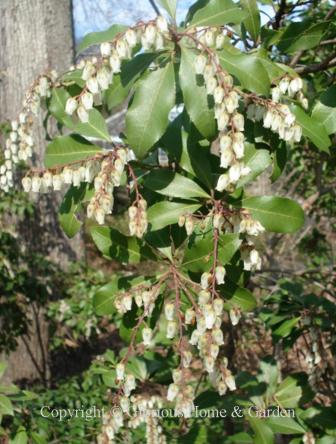 Pieris japonica
Pieris japonicaPittosporum tobira, Japanese pittosporum, Zones 8-10. This
attractive evergreen shrub looks neat through all seasons making it very popular for foundation and mass planting. The creamy white blooms in the spring smell like orange blossoms. 'Variegata' has white-edged leaves.
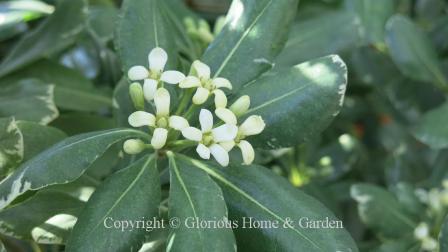 Pittosporum tobira
Pittosporum tobiraPrunus laurocerasus, cherrylaurel, Zones 6-8. This member of the cherry family is very popular for hedging. White flowers appear in spring and are followed by little dark purple "cherries" that can make a mess. Best not to plant where they can fall on cars! 'Otto Luyken' is shown.
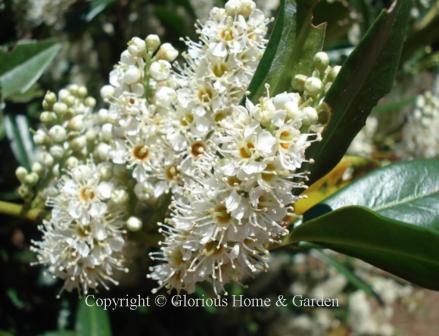 Prunus laurocerasus 'Otto Luyken'
Prunus laurocerasus 'Otto Luyken'Pyracantha coccinea, scarlet firethorn, Zones 6-9. Pyracantha is
valued for the masses of orange-red berries it produces in the fall, but the white flowers covering the plant is spring are very showy also. Beware of extremely sharp thorns--can be used to make an impenetrable barrier. Also nice to espalier on a wall.
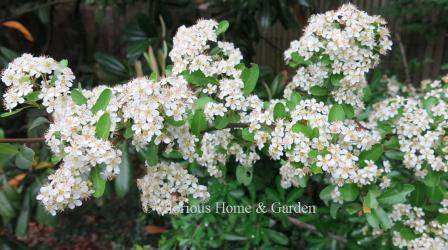 Pyracantha coccinea
Pyracantha coccineaClick here for spring flowering shrubs A - E.
Click here for spring flowering shrubs R - Z.
Plant of the Month
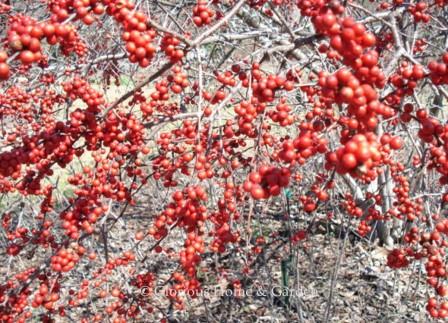
Ilex verticillata
Winterberry holly
Updated new USDA Plant Hardiness Zone Map 2023.